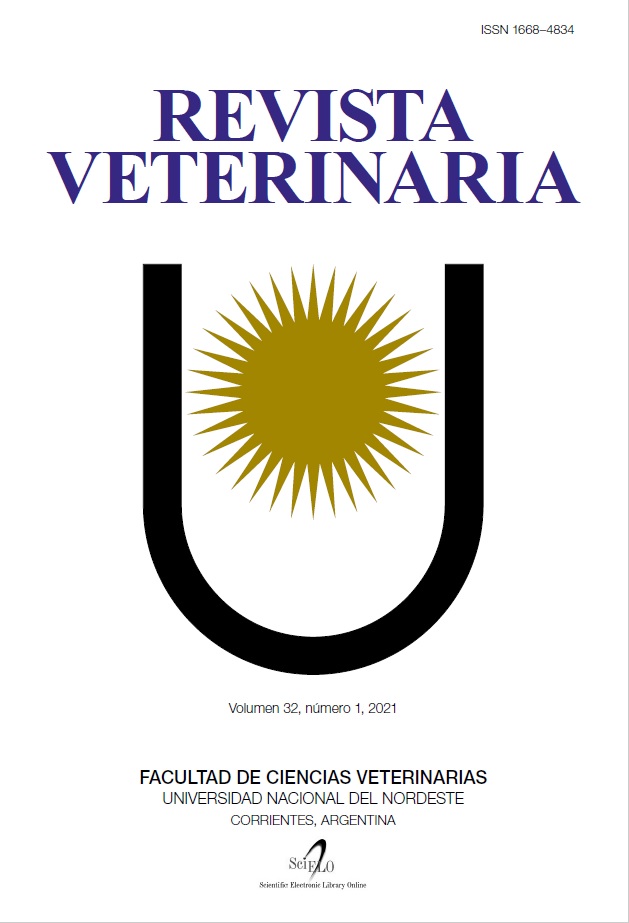Identification of cultivable bacterial strains present in Scomber japonicus peruanus salted using a fragment of the 16S rRNA gene
DOI:
https://doi.org/10.30972/vet.3215638Keywords:
Scomber japonicus, salted fish, genomics, bacteria, 16S ARNr geneAbstract
Salting fish is an ancient and economical form of preservation that is still used in developing countries such as Peru. In the Tumbes region, it is common the commercialization of mackerel (Scomber japonicus peruanus) salted by hand, so its microbiological safety is not guaranteed. The investigation aimed to identify, by sequencing a fragment of the 16S rRNA gene, the cultivable bacteria present in salted mackerel marketed in Tumbes. From mackerel muscle tissue, bacterial strains were isolated in TSA medium supplemented with 15% NaCl, from which fragments of the 16S rRNA gene were obtained and sequenced to identify the species to which they belonged through a search in Genbank. Additionally, the moisture and NaCl content of the salted mackerel muscle were analyzed. As a result, typical strains of salted products were identified such as Staphylococcus sp, Halomonas sp, Staphylococcus equorum, Salinivibrio sp, Staphylococcus nepalensis, and Salinivibrio sp. However, in 70% of mackerels analyzed, there were inadequate humidity levels, as well as low levels of NaCl that indicated an inadequate salting and consequently a product of poor conservationDownloads
References
Balbuena ED. 2014. Manual básico sobre procesamiento e inocuidad de productos de la acuicultura. Minist. Agric. Ganad. Paraguay. On line: http://www.racua.net/upload/medManual_ procesamiento_PY.pdf.
Condori Ch. 2014. Deterioro y Conservación de Alimentos. Tesis para optar por el título de Ingeniero de Industrias Alimentarias. Univ. Nac. San Agustín, Fac. de Ing. de Procesos, Escuela Prof. de Ing. de Industrias Alimentarias, p.143.
Delacruz S y Roncal J. 2014. Conservación de alimentos mínimamente procesados. Tesis p/optar título Ing. Químico, Univ. Nac. Trujillo, Fac. Ing. Quím., Perú. 119 p.
Dulanto JR. 2013. Identificación rápida de especies del género Vibrio asociados con el cultivo de “langostino blanco”. Tesis Biología, Univ.Nac.Mayor San Marcos, 109 p.
Escobar KE y Hernández C. 2012. Análisis de bacterias patógenas en Sardina Salada-Seca. Tesis p/Licenciat. Biología, Univ.El Salvador, Escuela Biología, 124 p.
Guzman K. 2017. Calidad en la logística de alimentos perecibles. Titulación por examen profesional. Univ. Nac. Agraria Molina, Facult. Industr. Aliment., 52 p.
Grau C, Elguezabal L, Vallenilla O., Zerpal A. 2003. Evaluación de la flora microbiana halófila contamínate del pescado seco-salado. Instit. Univ. Tecnol. Cumaná, Venezuela. Rev Cient FCV-LUZ 13: 319-325.
Guan L, Cho KH, Lee JH. 2011. Analysis of the cultivable bacterial community in Jeotgal. Food Microbiology 28: 101-103.
INEI (Instituto Nacional de Estadística e Informática). 2014. Compendio Estadístico Perú 2014. Lima, Perú. On line: https://www.inei.gob.pe/media.
ITP (Instituto Tecnológico Pesquero del Perú). 2001. Guía para la instalación y operación de establecimientos dedicados al salado del pescado. Perú.
Jonghoon L, Sojeong H, Dowon J. 2018. Genomic insights into Staphylococcus equorum KS1039 as a potential starter culture for the fermentation of high-salt foods. BMC Genomics 19: 136.
León E. 2011. Muestreo estacional del contenido graso en músculos de “caballa” Scomber japonicus. Tesis para obtener grado de Biología, Univ. Nac. Callao, 98 p.
López L, Dávila L. 2005. Salado de merluza por pila seca, húmeda y por deshidratación osmótica a vacío (Merluccius gayi peruanus). Industrial data 8: 2.
López C. 2017. Análisis filogenético y genómico del género Salinivibrio. Tesis Doctoral, Universidad de Sevilla. 338 p.
López HC, Haba RR, Sánchez PC, Ventosa A. 2018. Salinivibrio Kushneri sp, a moderately halophilic bacterium isolated from salterns. Systematic and Applied Microbiology 41: 159-66.
OMS (Organización Mundial de la Salud). 2018. Codex alimentarius. Normas internacionales de los alimentos. On line:http://www.fao.org.pdf.
Pérez LM. 2005. Variabilidad genética de cepas nativas de Azospirillum brasilense mediante análisis tipo PCRRFLP del DNA 16S ribosomal. Tesis para optar al grado de Maestro en Biotecnología Genómica. Inst.Politéc.Nac., Reynosa, México, 107 p.
Romero JJ, Negrete RM. 2011.Presencia de bacterias gram positivas en músculo de pescado con importancia comercial en la zona del Caribe mexicano. Revista Mexicana de Biodiversidad 82: 599-606.
Rodicio M, Mendoza M. 2004. Identification of bacteria through 16S rRNA sequencing: principles, methods and applications in clinical microbiology. Enferm Infec y Microbiol Clínica 22: 238-245.
Spergser J et al. 2003. Staphylococcus nepalensis sp Nov, isolated from goats of the Himalaya region. Internat J Systemat & Evolut Microbiol 53: 2007-2011.
Zhang H et al.: 2015. Microbiological changes and biodiversity of cultivable indigenous bacteria in Sanbao Larger Yellow Croaker (Pseudosciaena crocea). J of Food Sci 80: 4 (M776-M781).
Downloads
Published
How to Cite
Issue
Section
License
Revista Veterinaria (Rev. Vet.) maintains a commitment to the policies of Open Access to scientific information, as it considers that both scientific publications as well as research investigations funded by public resources should circulate freely without restrictions. Revista Veterinaria (Rev. Vet.) ratifies the Open Access model in which scientific publications are made freely available at no cost online.











.jpg)
.jpg)



